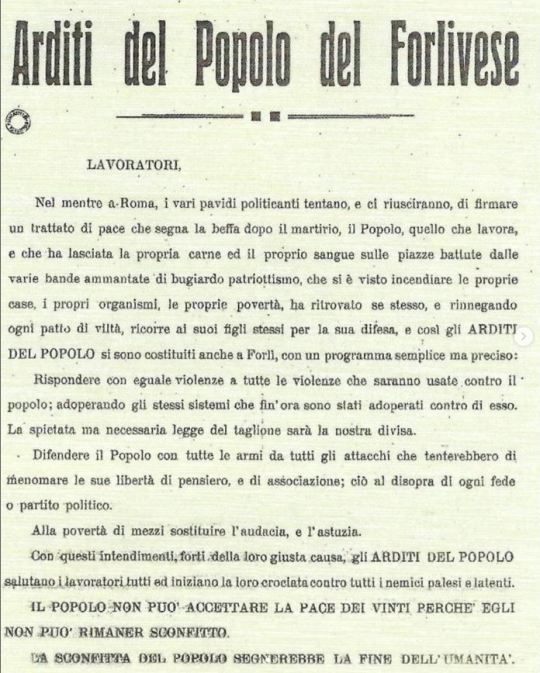#arditidelpopolo
Explore tagged Tumblr posts
Text
SIAM DEL POPOLO GLI ARDITI


Per rispondere alle violenze dello squadrismo, nel giugno del 1921 nacquero a Roma gli Arditi del Popolo, squadre di proletari con lo scopo di combattere il fascismo sul loro stesso terreno: quello dello scontro armato. La tendenza anarchica del movimento portò i partiti socialista, comunista e repubblicano a prenderne le distanze. In Romagna erano presenti sicuramente nel ravennate e nel riminese. Su Cesena si dice non fossero presenti, così come a Forlì, almeno secondo alcuni dirigenti comunisti che nel dopoguerra affermarono che ci furono alcune riunioni tra socialisti, comunisti e anarchici forlivesi ma alla fine non se ne fece nulla. In realtà, il 21 luglio, 'La Romagna socialista' dava notizia della loro formazione anche a Forlì. Negli stessi giorni, al funerale del comunista Pietro Casadei, ucciso durante alcuni scontri a Cesena, tramite un manifesto la famiglia ringraziò apertamente le squadre comuniste e gli Arditi del Popolo. Il 28 agosto su 'La lotta di classe' si parla di loro: “Abbiamo ricevuto un elenco di sottoscrizioni per Arditi del Popolo da Forlì”, mentre lo studioso locale Elio Santarelli li descrisse come dei "gruppi paramilitari che a Forlì si costituirono nel luglio 1921 seguendo l’esempio di altre parti d’Italia". Anche 'Il Pensiero Romagnolo' ne parlò, scrivendo che "alle bande fasciste si oppongono le bande proletarie.” Per togliere ogni dubbio, ho trovato due volantini firmati proprio dagli Arditi del Popolo forlivesi: uno (del quale ho tagliato una lunga citazione nella parte centrale) per chiamare il popolo a manifestare contro la pena inflitta agli anarchici Sacco e Vanzetti; l’altro per indignarsi dell'imminente patto di pacificazione tra socialisti e fascisti, e annunciare la nascita del movimento in città e la sua precisa finalità: “Rispondere con eguale violenza a tutte le violenze che saranno usate contro il popolo; adoperando gli stessi sistemi che finora sono stati adoperati contro di esso. La spietata ma necessaria legge del taglione sarà la nostra divisa!"
9 notes
·
View notes
Photo

Today's mood/homework assignment: read about #arditidelpopolo. An antifascist group in the 1920s that managed to repel 20000 blackshirts from taking Parma. Yes THAT Parma as in cheese and ham. Back then, the fascists had not yet taken over. People would still stand against them, often to their end. We're quite literally repeating the last century and it's frightening. (at Mulberry St, Little Italy)
0 notes